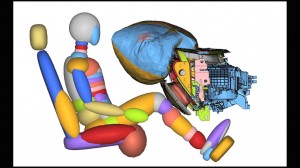
Ford has developed a new passenger knee airbag design integrated into the glovebox door that will debut on the all-new 2015 Ford Mustang.
In all the hubbub surrounding introduction of the 2015 Ford Mustang, the maker of the pony car didn’t play up a safety innovation…until now: the knee airbag.
While a knee airbag isn’t exactly revolutionary, Ford engineers have developed a new iteration that provides improved safety and more options for the company’s design team.
Ford uses an inflatable plastic bladder that is integrated into the glove box door and provides front passenger knee protection similar to a conventional knee airbag mounted under the instrument panel. The upside to the new airbag is that it requires half the material and an inflator that is 75% smaller than one for a conventional knee airbag.
“We provide a high level of safety, quality and design for our customers and their passengers,” said Sean West, Ford restraints manager. “With this innovative airbag design, we have developed technology that provides protection for vehicle occupants while also reducing weight and enabling greater design flexibility.”
The bladder is made of a newly developed plastic rather than the fabric used in conventional airbags. When it detonates, the entire glove box door panel pushes forward, cutting down the distance airbag must travel. Most knee airbags must come from underneath the dashboard, which takes longer to travel to the knee and it doesn’t remain in place as long.
The improved packaging of the system is more discreet, with no visible seams or airbag cover, the automaker said. This has given designers more flexibility to move the dashboard closer to the windshield, enhancing the feeling of roominess in the cabin.
In developing the new Mustang passenger knee airbag, Ford has been granted 15 U.S. patents already, with more patents filed.
(Is your car concealing a deadly defect? Find out by Clicking Here.)
This improved approach comes as automakers around the globe are struggling with airbag issues. GM’s recalled nearly 6 million vehicles due to airbag problems while another 3 million vehicles from Toyota, Honda and Nissan as well as additional vehicles from Chrysler were recalled today.
Those vehicles use inflators produced by Takata Inc., which has been involved in airbag-based recalls of more than 10 million vehicles during the past 18 months. The issue appears to be the result of improper handling and processing, at factories in the U.S. and Mexico, of the explosive materials used to inflate airbags.
(Click Here to get details about new car buyers driving fuel economy improvements.)
Takata, one of the world’s largest producers of airbags – among many automotive components – has had a series of technical and legal problems in recent years.
(To see more about 3 million vehicles recalled for airbag problems, Click Here.)
The various airbag issues it has confirmed in recent years have been linked to a number of injuries and fatalities, including two deaths in 2009 that Honda confirmed last year when it announced its original airbag recall.
Last year, Takata confirmed it had sold faulty airbags to not only Toyota, Nissan, Honda and Mazda, but also BMW and General Motors – all five of which had recalls to address the problem. It is unclear if either GM or BMW now might have to expand those earlier service actions.
